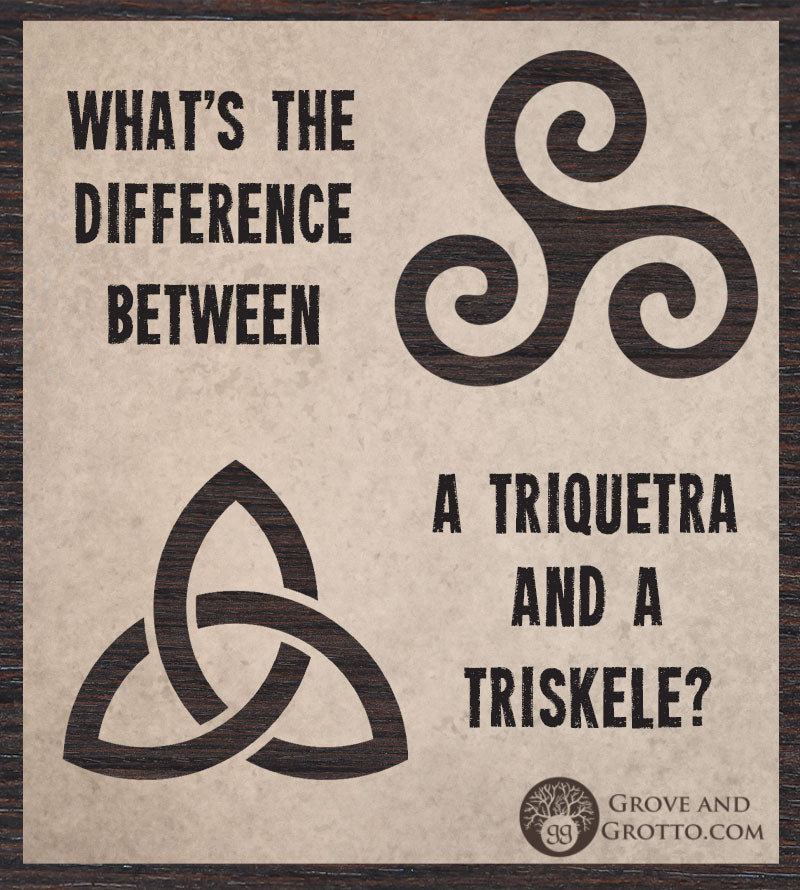
Do you know the difference between a triskele and triquetra? If you don’t, you’re not alone! Lots of people ask us this question when shopping for a special symbolic piece of jewelry. Learn about these two sacred emblems and how they’re used in Pagan practice.
Triskele
We’ll start with the triskele. (Sometimes it’s called a triskelion—same thing, both terms come from the Greek words for “three-legged.”) The triskele is a triple spiral with equally spaced arms or legs. There are lots of different variations of this symbol. The spirals can be curved or sharply angled, single- or double-lined. Sometimes the arms join at a single point, or sometimes they form a triangle in the center. Often the spirals curve to the viewer’s right, suggesting rotation to the right—but not always.
The spiral and the triple spiral are among the oldest spiritual symbols created by humans. Triskeles were carved on Neolithic stones and many objects from the Bronze and Iron Ages. Because we don’t know much about the religious beliefs of pre-literate people, symbologists have had to speculate about what the triskele meant to them. The rayed arms and the suggestion of motion lead us to suppose that it was originally a Solar symbol.

From its pre-Celtic origins, the triskele has become widespread in Celtic art and architecture. Versions are found on ancient monuments across Ireland. As Christianity spread throughout the land, the triskele was re-interpreted as a symbol of the three-in-one person of the Holy Trinity. It continues to be used as a Trinitarian Christian motif.
For modern Pagans, especially Celtic Reconstructionist Pagans, the triskele is one of the main symbols of faith. It represents the three realms of Earth, Sea, and Sky. (Or terrestrial, spiritual, and divine energies.) The triskele is also worn by devotees of any number of triple deities, including Manannan, Hecate, and Brigid.
Besides the life-giving energy of the sun, spirals are also mystically related to the generative power of the womb. The triskele also may stand for fertility and renewal. Wiccans recognize the triskele as a symbol of the triple goddess—the Maiden, Mother, and Crone. Especially when drawn as a single connected line, the triskele can evoke the eternal cycles of life, death, and birth.
The triskele almost made the news in 2017, when Pagan activists petitioned for a Druid symbol to be among those allowed on veterans’ headstones in the United States. However, the symbol ultimately chosen for this purpose was the Awen.
Triquetra
The triquetra is an interwoven Celtic knot figure with three points. (The word means “three-cornered.”) It is technically an elaboration of the geometric figures called vesicae piscis.
Truth be told, there are more similarities than differences between the triquetra and the triskele. Both are holy symbols to Christians and to Pagans. Both are best known for their origins in Celtic and pre-Celtic Britain. And both represent a variety of sacred trinities.
In contemporary Ireland, the triquetra is sometimes called a “lovers’ knot” and is exchanged as a token of love or betrothal. It stands for the threefold promise “to love, to honor, and to protect.” Its shape recalls the three leaves of the clover, a plant dear to Ireland and once used by St. Patrick to explain the Holy Trinity. In early Christian art, the three lobes of the triquetra are sometimes rendered as fishes. As a symbol of Christianity, the triquetra is older than the crucifix. Though it appears in such important works as the Book of Kells, some people maintain that is more of a decorative element than a stand-alone emblem of belief.
Wiccans and Pagans wear the triquetra in honor of the Triple Goddess, and also as a protective amulet. Because the shape has no beginning and no end, it represents eternity and the mystery of creation. The triquetra’s connection to modern witchcraft no doubt got a boost from the television show Charmed. The witches in the show have a Book of Shadows emblazoned with a triquetra, a symbol of the three sisters weaving their magic together. We’ve found that the triquetra is a popular “subtle” symbol for customers who want to wear a Pagan symbol but choose not to display a pentacle.
Norse-influenced Pagans also claim the triquetra as their own, as it appears on runestones and early Germanic coins. It is similar in appearance to the valknut (shield of Odin). Like the triskele, the triquetra has many variations. It may be interlaced with a circle, triangle, or heart—or compounded together to make more elaborate shapes.
The Magick of Three
The popularity of the triskele and the triquetra as religious symbols alludes to a greater truth—the mystical significance of the number three. You don’t have to dig very deeply in any belief system to find trinities at the core. Thinking of the world in terms of threes is an ancient way of avoiding duality of thought—the “black and white” worldview that cripples learning and spiritual growth.
For Pagans, the trinities of “maiden, mother, crone” and “earth, sea, and sky” are perhaps the most common correspondences with the triquetra and triskele. But there are many others: Mind, body, spirit. Mother, father, child. Sulfur, salt, mercury. Thought, word, deed. Yesterday, today, tomorrow.
The meaning of symbols changes across time, but ultimately the most important thing is what it means to you! No doubt these ancient sacred symbols will persist for thousands of years to come.
Shop for Celtic jewelry, or read our other articles here.


